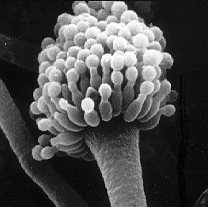Many cancer patients who receive high doses of chemotherapy or radiation undergo a bone marrow transplant to replace blood cell-generating tissues that are killed as part of their treatment. But after a transplant these patients face a new challenge — opportunistic infections that take advantage of their weakened immune systems.
 Aspergillus fumigatus
Aspergillus fumigatus
One common and life-threatening infection among bone marrow transplant patients is invasive aspergillosis (IA), which is caused by the fungus Aspergillus fumigatus. About 10% of bone marrow transplant recipients are affected by invasive aspergillosis (IA). An estimated 30% of those affected will die within three months.
A study published in the June issue of PLoS Genetics shows that a SNP in the gene encoding a protein called plasminogen significantly affects the risk of developing IA after a bone marrow transplant. Compared to transplant patients with the GG genotype at rs4252125, the risk of developing IA was increased 3.0 fold in people with the AG genotype, and 5.6 fold for people with the AA genotype.
Zaas et al began their study of IA in bone marrow transplant patients by looking for clues in several genetically distinct strains of mice. The researchers mimicked a bone marrow transplant in the mice by giving them drugs that suppressed their immune systems. They then exposed the animals to the Aspergillus fungus.
The researchers found that some mouse strains survived Aspergillus infection, while others did not. A SNP in the plasminogen gene correlated with Aspergillus susceptibility, and the researchers considered it a likely candidate because other scientists had recently indicated that proteins in the same biological pathway as plasminogen are important for fighting off infectious pathogens.
Armed with this clue from mice, Zaas et al turned their attention to humans. They followed a group of 230 immunosuppressed bone marrow transplant recipients for one year. Just as they had seen in the mice, the researchers found that IA was associated with a SNP (rs4252125) in the plasminogen gene.
Oddly, the association between rs4252125 and IA applies only 40 days or more post-transplant. The authors aren’t exactly sure why this is the case. It could be due to the low proportion of patients who are infected with Aspergillus in the first 40 days after their transplants. It could also be that until 40 days, when the transplanted bone marrow really starts to take hold, other risk factors swamp out the effect of rs4252125.
Laboratory tests showed that the plasminogen protein encoded by rs4252125, which is made in the liver, binds to Aspergillus fungus. And computer models indicate that the SNPs found in both mice and humans change the protein in a way that alters binding to the fungus, giving a possible explanation for why the SNP affects susceptibility to IA.
Though more research and evaluation is required before clinical applications can be developed based on this research, the authors write in the conclusion of their report that their results have “important implications for pre and post transplant care, and may also have implications for the management of other immune-compromised patients. For example, genetic testing could identify high risk individuals who may benefit from use of broad-spectrum antifungal agents or enhanced monitoring for infection.”



